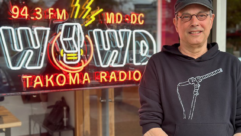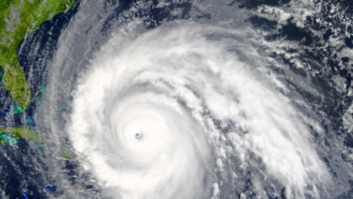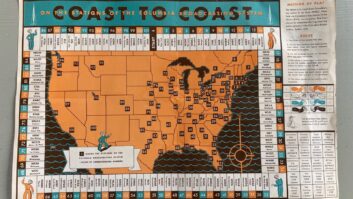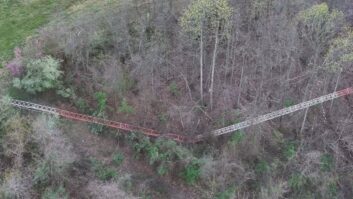
Luca Brooms works in the new Fun Radio on-air studio. BRUSSELS — Fun Radio (www.funradio.be) has just completed an ambitious upgrade plan, launched in 2009, to boost its output, efficiency and broadcast quality.
As part of the modernization scheme, the dance-format network renewed its transmitter and antenna park by upgrading its 20 broadcast sites with Elettronika Mizar transmitters and Omnia One processors at each location. The broadcaster has also updated its existing RDS system with Deva Broadcast RDS/RBDS encoders.
Technical advancement
“We wanted to continue our technical evolution,” said Gregory Finn, managing director of Fun Radio. “Part of our technical configuration needed modernization and the renewal of the transmitter park results in a substantial improvement of the ‘on-air’ sound thanks to the individual processors.”
Finn explains that, when in 2008 the new frequency plan for the Belgian French-speaking community was put in place for the following nine years, Fun Radio Belgique, with 20 frequencies serving the South of Belgium, kicked off its technical upgrade operation.
“The first step in 2009 was to replace our satellite transmission system with the latest VPN [Virtual Private Network] technology. We use VPN for signal transmission to network affiliates, with a dedicated link between the Brussels-based parent station and the local stations,” said Finn.

A Fun Radio Logo
“This technology also allows remote monitoring of the local equipment such as the Omnia One processors and the RDS gear. In the case of an emergency, remote operation is also possible.”
While the first VPN transmissions used Symmetric Digital Subscriber Line (SDSL) connections, explains Finn, Fun has shifted to VDSL with WIN — Very high bit rate DSL with Wireless Intelligent Network — with the most recent update taking place last summer. The new configuration offers the transfer of larger data-packs and the use of both symmetric and asymmetric services. “The big advantage is a robust and steady signal transfer, whereas the satellite link suffered from meteorological conditions,” he said.
The next phase in Fun Radio’s refurbishment plan was the installation of new studio facilities at the station’s headquarters, located in the community of Forest in Brussels. Today, spacious twin studios are at the heart of the the network. Each of the fully digital studios is equipped with SAS Rubicon-SL consoles, Deva RDS encoders, JBL LSR4300 monitors, AirTools X2 voice processors and Omnia.11 audio processors.
Improved sound
The studios are used both for production and broadcast — TVV Sound provided the equipment. TVV also manages and oversees maintenance for Fun Radio’s antenna and transmitter park.
“We started with the installation of Aldena dipole antennas (with two or three elements, depending on the site configuration) some 18 months ago,” said Edo Dijkstra, TVV Sound managing director.
“In May, we began the installation of the new transmitters. They were built in separate racks allowing swift replacement at the different sites. In fact, the whole project was very interesting. It’s unusual in these times of financial crisis that a radio broadcaster decides to refurbish the technical configuration of its entire network from scratch.”

Luca Brooms is host of the morning drive show ‘Le Self.’
Finn echoes Dijkstra’s enthusiasm. “The combination of new digital consoles and the new transmitter park results in a greatly improved sound, and the remote control system further enhances our efficiency and flexibility,” he said.
The network produces all of its programs in Brussels and transmits them to the 20 sites. Fun Radio integrates radio advertising in each program, and routes specific local publicity to 15 urban stations via VDSL. A Rohde & Schwarz SR8000 transmitter sends the signal from the Brussels site.
Fun Radio employs some 90 people in Belgium — 15 of the station’s frequencies are owned by FM Developpement, five others are franchise operations.
Fun spirit
“For all our programs, we keep the same Fun Radio spirit, even if we sound slightly different from the French original. We produce all our programs in Brussels but maintain the Fun strategy — with lots of ‘fun’ and interactivity,” Finn said. “It’s a slightly different blend, which is specific for our market but it respects the original Fun brand, just like the newly launched Fun Radio in Spain does.”

Gregory Finn is managing director of Fun Radio.
Recent ratings released from Centre d’Information sur les Médias places Fun Radio in front of stations such as public station Pure FM (RTBF) and commercial station NRJ. Fun is particularly strong in urban areas like Charleroi, where it leads the pack in the 18–35 age bracket.
Finn is convinced, however, that the station’s audience is affected by the poor coverage generated by the frequency plan. “Our recent investments don’t really solve the coverage problem,” he said.
“But if we want to continue our activities, we must stick to our plan. It’s a huge operation with a positive impact on Fun Radio’s commercialization — the improvement of our broadcast quality, the implementation of new programs, such as our morning drive show ‘MIKL à la Radio,’ and the evening talk show ‘Libre Antenne,’ brings Fun, content-wise, closer to its target audience.”
In addition to the substantial investment in broadcast gear, the final step for the network was to renew its Internet engine, says Finn. “We also launched iPhone apps, and increased our external marketing efforts through outside broadcasts and programs coverage on events and in clubs.”
Marc Maes reports on the industry for Radio World from Antwerp, Belgium.










